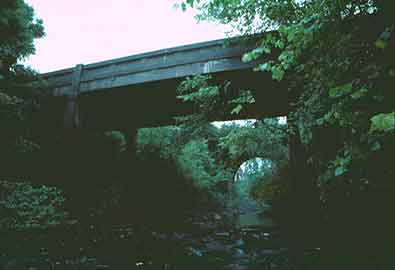We Recommend:
Bach Steel - Experts at historic truss bridge restoration.
BridgeHunter.com Phase 1 is released to the public! - Visit Now
Ramsay Bridge

Primary Photographer(s): James Rouse
Bridge Documented: June 19, 2007
Ramsay: Gogebic County, Michigan: United States
1922 By Builder/Contractor: P. N. Massie of Bessemer, Michigan and Engineer/Design: Michigan State Highway Department
Not Available or Not Applicable
50.0 Feet (15.2 Meters)
130.0 Feet (39.6 Meters)
22 Feet (6.71 Meters)
3 Main Span(s)
27200005000B010

View Information About HSR Ratings
Bridge Documentation
View Archived National Bridge Inventory Report - Has Additional Details and Evaluation
This bridge sits next to the equally rare and beautiful Keystone Bridge. The Ramsay Bridge is an impressive example of a concrete girder bridge, as it sweeps over the small valley of the Black River. Such use of the concrete girder bridge was not often seen in Michigan; concrete girders were generally used for smaller crossings that did not have a valley to them. The bridge is significant as the largest remaining example of a straight chord through girder bridge in Michigan. Unfortunately, the bridge has not been maintained and serious concrete spalling has marred the beauty of the structure. It is paramount that this bridge be restored, with attention paid to bringing back the original appearance of the bridge. As a significant and impressive example of this structure type, it should be receive more attention than it currently has been.
Information and Findings From Michigan Historic Bridge InventoryNarrative Description
This three-span concrete bridge carries
Main Street over the Black River in the center of the village of Ramsay.
Built in 1922-1923 from a design by the Michigan State Highway
Department, the Ramsay Bridge is comprised of a 50-foot concrete through
girder, flanked on both sides by similarly configured, 40-foot girders.
The superstructure is supported by concrete abutments and spill-through
piers with tapered columns and straight diaphragms. It features typical
MSHD detailing with two straight girders that carry the
asphalt-surfaced, concrete slab deck. The modest architectural
expression is provided by recessed rectangular panels in the girder
walls, which are capped with heavy concrete corbels. Bronze "State
Reward Bridge" plates are mounted on the girder's sidewalls. Other than
minor concrete spalling, the Ramsay Bridge remains essentially unaltered
and in physically good condition. |
![]()
Photo Galleries and Videos: Ramsay Bridge
Bridge Photo-Documentation
A collection of overview and detail photos. This photo gallery contains a combination of Original Size photos and Mobile Optimized photos in a touch-friendly popup viewer.Alternatively, Browse Without Using Viewer
![]()
Maps and Links: Ramsay Bridge
Coordinates (Latitude, Longitude):
Search For Additional Bridge Listings:
Bridgehunter.com: View listed bridges within 0.5 miles (0.8 kilometers) of this bridge.
Bridgehunter.com: View listed bridges within 10 miles (16 kilometers) of this bridge.
Additional Maps:
Google Streetview (If Available)
GeoHack (Additional Links and Coordinates)
Apple Maps (Via DuckDuckGo Search)
Apple Maps (Apple devices only)
Android: Open Location In Your Map or GPS App
Flickr Gallery (Find Nearby Photos)
Wikimedia Commons (Find Nearby Photos)
Directions Via Sygic For Android
Directions Via Sygic For iOS and Android Dolphin Browser
USGS National Map (United States Only)
Historical USGS Topo Maps (United States Only)
Historic Aerials (United States Only)
CalTopo Maps (United States Only)


